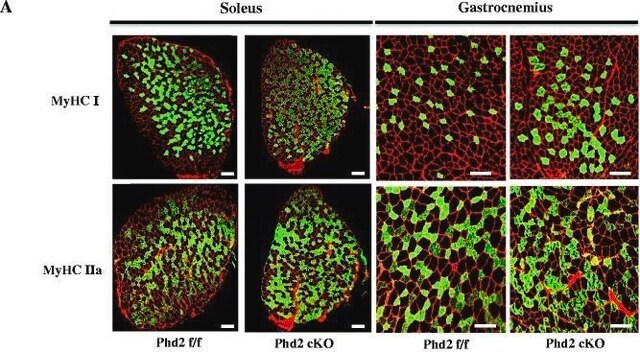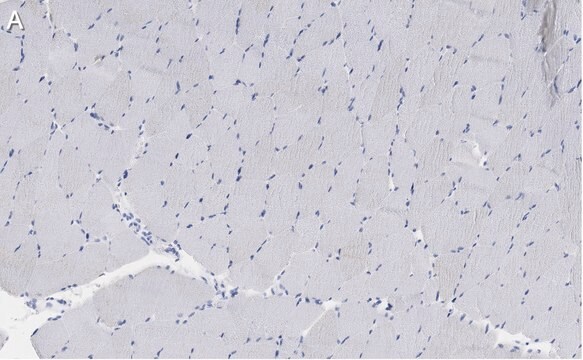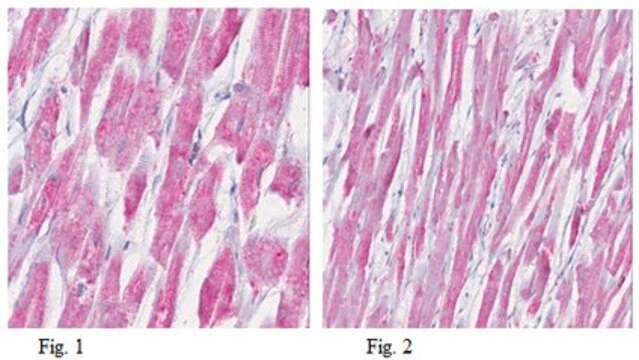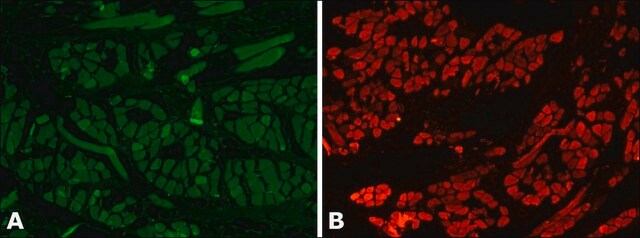MABT840
Anti-Myosin-2 (MYH2) Antibody, clone SC-71
clone SC-71, from mouse
Synonym(e):
Myosin-2, MyHC-2a, MyHC-IIa, Myosin heavy chain 2, Myosin heavy chain 2a, Myosin heavy chain IIa, Myosin heavy chain, skeletal muscle, adult 2
About This Item
Empfohlene Produkte
Biologische Quelle
mouse
Qualitätsniveau
Antikörperform
purified immunoglobulin
Antikörper-Produkttyp
primary antibodies
Klon
SC-71, monoclonal
Speziesreaktivität
human, opossum, rat, mouse
Darf nicht reagieren mit
guinea pig
Speziesreaktivität (Voraussage durch Homologie)
bovine (based on 100% sequence homology)
Methode(n)
immunofluorescence: suitable
immunohistochemistry: suitable
western blot: suitable
Isotyp
IgG1κ
NCBI-Hinterlegungsnummer
UniProt-Hinterlegungsnummer
Versandbedingung
ambient
Posttranslationale Modifikation Target
unmodified
Angaben zum Gen
human ... MYH2(4620)
Allgemeine Beschreibung
Spezifität
Immunogen
Anwendung
Zellstruktur
Immunofluorescence Analysis: A representative lot immunostained type 2A fibers in mouse hindlimb muscle cryosections encompassing soleus and surrounding tissues (Kurapati, R., et al. (2012). Hum. Mol. Genet. 21(8):1706-1724).
Immunofluorescence Analysis: A representative lot immunostained type 2A fibers in rat soleus muscle cryosections following Bupivacaine-induced muscle regeneration. In tetrodotoxin/TTX-paralyzed-regenerated muscles type 2A MHC was not expressed (Midrio, M., et al. (2002). Basic Appl. Myol. 12(2): 77-80).
Immunohistochemistry Analysis: A representative lot detected type IIA myosin heavy chain (MyHC) in human masseter (jaw) muscle cryosections (Horton, M.J., et al. (2001). Arch. Oral Biol. 46(11):1039-1050).
Immunohistochemistry Analysis: Representative lots immunostained type 2A, but not type 1, 2B, or 2X, fibers in soleus (rat) and tibialis (mouse, rat, and Mgray short-tailed opossum/Monodelphis domestica) anterior muscle cryosections. Clone SC-71 failed to stain guinea pig tibialis sections (Sciote, J.J., and Rowlerson, A. (1998). Anat. Rec. 251(4):548-562; Gorza, L. (1990). J. Histochem Cytochem. 38(2):257-265; Schiaffino, S., et al. (1989). J. Muscle Res. Cell Motil. 10(3):197-205).
Western Blotting Analysis: A representative lot detected type IIA myosin heavy chain (MyHC) in human masseter (jaw) single muscle fibres extract (Horton, M.J., et al. (2001). Arch. Oral Biol. 46(11):1039-1050).
Western Blotting Analysis: A representative lot detected myosin heavy chain (MHC) in myosin preparations from rat diaphragm, as well as the light meromyosin and rod, but not heavy meromyosin or S-1, fragments of MHC (Schiaffino, S., et al. (1989). J. Muscle Res. Cell Motil. 10(3):197-205).
Qualität
Isotyping Analysis: The identity of this monoclonal antibody is confirmed by isotyping test to be mouse IgG1 .
Zielbeschreibung
Physikalische Form
Lagerung und Haltbarkeit
Sonstige Hinweise
Haftungsausschluss
Sie haben nicht das passende Produkt gefunden?
Probieren Sie unser Produkt-Auswahlhilfe. aus.
Lagerklassenschlüssel
12 - Non Combustible Liquids
WGK
WGK 1
Analysenzertifikate (COA)
Suchen Sie nach Analysenzertifikate (COA), indem Sie die Lot-/Chargennummer des Produkts eingeben. Lot- und Chargennummern sind auf dem Produktetikett hinter den Wörtern ‘Lot’ oder ‘Batch’ (Lot oder Charge) zu finden.
Besitzen Sie dieses Produkt bereits?
In der Dokumentenbibliothek finden Sie die Dokumentation zu den Produkten, die Sie kürzlich erworben haben.
Unser Team von Wissenschaftlern verfügt über Erfahrung in allen Forschungsbereichen einschließlich Life Science, Materialwissenschaften, chemischer Synthese, Chromatographie, Analytik und vielen mehr..
Setzen Sie sich mit dem technischen Dienst in Verbindung.






